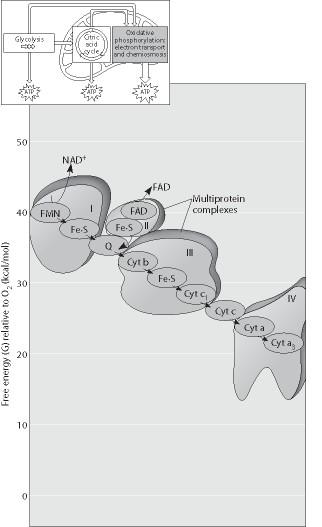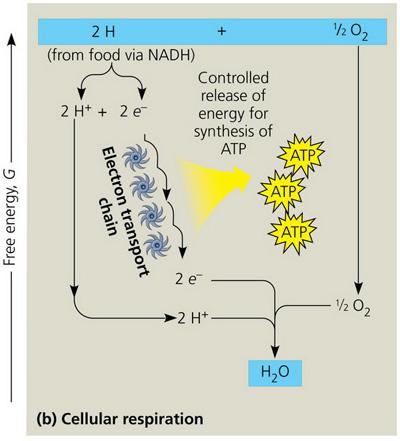Which of these enters the citric acid cycle?
acetyl CoA Acetyl CoA is a reactant in the citric acid cycle.
In the citric acid cycle, ATP molecules are produced by
substrate-level phosphorylation note: substrate-level phosphorylation
Which of these is NOT a product of the citric acid cycle?
acetyl CoA notE: Acetyl CoA enters the citric acid cycle.
A glucose molecule is completely broken down to carbon dioxide and water in glycolysis and the citric acid cycle, but together these two processes yield only a few molecules of ATP. What happened to most of the energy that the cell obtains from the oxidation of glucose?
It is stored in NADH and FADH2
Which statement about the citric acid cycle is correct?
The last reaction in the citric acid cycle produces a product that is a substrate for the first reaction of the citric acid cycle.
In mitochondrial electron transport, what is the direct role of O2?
to function as the final electron acceptor in the electron transport chain
How would anaerobic conditions (when no O2 is present) affect the rate of electron transport and ATP production during oxidative phosphorylation? (Note that you should not consider the effect on ATP synthesis in glycolysis or the citric acid cycle.)
Both electron transport and ATP synthesis would stop.
NADH and FADH2 are both electron carriers that donate their electrons to the electron transport chain. The electrons ultimately reduce O2 to water in the final step of electron transport. However, the amount of ATP made by electrons from an NADH molecule is greater than the amount made by electrons from an FADH2 molecule.
Which statement best explains why more ATP is made per molecule of NADH than per molecule of FADH2?
Fewer protons are pumped across the inner mitochondrial membrane when FADH2 is the electron donor than when NADH is the electron donor.
When the protein gramicidin is integrated into a membrane, an H+ channel forms and the membrane becomes very permeable to protons (H+ ions). If gramicidin is added to an actively respiring muscle cell, how would it affect the rates of electron transport, proton pumping, and ATP synthesis in oxidative phosphorylation? (Assume that gramicidin does not affect the production of NADH and FADH2 during the early stages of cellular respiration.)
Sort the labels into the correct bin according to the effect that gramicidin would have on each process.
remains the same: proton pumping rate, electron transport rate, rate of oxygen uptake
decreases(or goes to zero):rate of ATP synthesis, size of the proton gradient
The four stages of cellular respiration do not function independently. Instead, they are coupled together because one or more outputs from one stage functions as an input to another stage. The coupling works in both directions, as indicated by the arrows in the diagram below. In this activity, you will identify the compounds that couple the stages of cellular respiration.
Drag the labels on the left onto the diagram to identify the compounds that couple each stage. Labels may be used once, more than once, or not at all.
look at item 6a
Under anaerobic conditions (a lack of oxygen), the conversion of pyruvate to acetyl CoA stops.
Which of these statements is the correct explanation for this observation?
In the absence of oxygen, electron transport stops. NADH is no longer converted to NAD+, which is needed for the first three stages of cellular respiration.
Suppose that a cell’s demand for ATP suddenly exceeds its supply of ATP from cellular respiration.
Which statement correctly describes how this increased demand would lead to an increased rate of ATP production?
ATP levels would fall at first, decreasing the inhibition of PFK and increasing the rate of ATP production.
What would happen to the cell’s rate of glucose utilization?
Glucose utilization would increase a lot.
The electrons stripped from glucose in cellular respiration end up in which compound?
water At the end of the electron transport chain, the electrons and hydrogen atoms are added to oxygen, forming water.

What happens at the end of the chain in the figure?
4 electrons combine with a molecule of oxygen and 4 protons.
Match each product of pyruvate metabolism with the condition under which it is produced.
Lactate: Fermentation in human muscle
ethanol: Fermentation in yeast and bacteria
Acetyl CoA: Aerobic Oxidation
Sort the following items according to whether they are reactants or products in the anaerobic reduction of pyruvate during lactic acid fermentation.
Reactants: NADH & Pyruvate
Products: NAD+ & Lactate
In muscle cells, fermentation produces _____.
lactate and NAD+
In fermentation _____ is reduced and _____ is oxidized.
pyruvate ... NADH
Which molecule is metabolized in a cell to produce energy for performing work?
Glucose
True or false? The potential energy in an ATP molecule is derived mainly from its three phosphate groups.
True
Which process is not part of the cellular respiration pathway that produces large amounts of ATP in a cell?
Fermentation
Which step of the cellular respiration pathway can take place in the absence of oxygen?
Glycolysis
Into which molecule are all the carbon atoms in glucose ultimately incorporated during cellular respiration?
Carbon dioxide
Which of the following statements about the electron transport chain is true?
NADH and FADH2 donate their electrons to the chain.
Which stage of glucose metabolism produces the most ATP?
Electron transport and chemiosmosis
True or false? The reactions that generate the largest amounts of ATP during cellular respiration take place in the mitochondria.
True
In the absence of oxygen, what is the net gain of ATP for each glucose molecule that enters glycolysis?
two ATP Four ATP are made, but two ATP are consumed to start the process of glycolysis.
Which metabolic pathway is common to both cellular respiration and fermentation?
glycolysis
In most cells, not all of the carbon compounds that participate in glycolysis and the citric acid cycle are converted to carbon dioxide by cellular respiration. What happens to the carbon in these compounds that does not end up as CO2?
The carbon compounds are removed from these processes to serve as building blocks for other complex molecules.
The carbon compounds are removed from these processes to serve as building blocks for other complex molecules.
carbohydrates only.
The immediate energy source that drives ATP synthesis by ATP synthase during oxidative phosphorylation is the
H+ concentration across the membrane holding ATP synthase.
Which metabolic pathway is common to both fermentation and cellular respiration of a glucose molecule?
glycolysis
In mitochondria, exergonic redox reactions
provide the energy that establishes the proton gradient.
The final electron acceptor of the electron transport chain that functions in aerobic oxidative phosphorylation is
oxygen
What is the oxidizing agent in the following reaction? Pyruvate + NADH + H+ → Lactate + NAD+
pyruvate
When electrons flow along the electron transport chains of mitochondria, which of the following changes occurs?
The pH of the matrix increases.
Most CO2 from catabolism is released during
the citric acid cycle.
Which of the following statements accurately describes the function of a metabolic pathway involved in cellular respiration?
The function of glycolysis is to begin catabolism by breaking glucose into two molecules of pyruvate, with a net yield of two ATP.
Glycolysis is the first stage in cellular respiration and does not depend on the presence of oxygen.

In cellular respiration, a series of molecules forming an electron transport chain alternately accepts and then donates electrons. What is the advantage of such an electron transport chain?
The advantage of an electron transport chain is that a small amount of energy is released with the transfer of an electron between each pair of intermediates.
How will a healthy individual’s ATP production change during an eight-hour fast?
The individual’s ATP production will not change significantly.
Identify all correct statements about the basic function of fermentation.
Select all that apply.
The basic function of fermentation is the regeneration of NAD+, which allows continued ATP production by glycolysis.
note:Fermentation occurs in the absence of oxygen and does not yeild as much ATP. Read about fermentation.
Select the correct statement about cellular respiration.
Cellular respiration and breathing differ in that cellular respiration is at the cellular level, whereas breathing is at the organismal level.